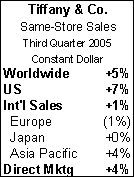IDEX Online Research: Big Diamonds Fuel Tiffany’s Sales
December 22, 05 by Ken Gassman

Tiffany & Co., the world-renowned jeweler, posted solid sales for this third fiscal quarter ended October, 2005. Its U.S. retail division generated a high single digit gain, while its international store sales were up very modestly. The direct marketing division generated a mid-single digit gain, somewhat below plan. Finally, its only other significant retail division, Little Switzerland, generated a strong sales gain: +10 percent. Highlights from the quarter include the following:
U.S. Retail – Sales in its U.S. retail stores, which represent roughly half of Tiffany’s total revenues, were up 9 percent; same-store sales advanced by 7 percent. Sales were driven by gains from new stores as well as solid same-store sales trends in existing stores.
- The New York Fifth Avenue flagship store posted a sales gain of 12 percent in the quarter. However, this increase was driven entirely by tourists, rather than local New York shoppers.
- U.S. branches generated an aggregate 6 percent sales gain.
- California stores posted a 9 percent gain.
- Hawaii was soft due to lack of tourist traffic.
- The strongest stores were located in Charlotte NC, Chicago IL, Dallas TX, San Jose CA, and Bellevue WA.
- Store traffic and transactions were flat, but jewelry unit volume was up.
- Greater sales of high-priced diamonds helped boost sales. Sales of diamonds over $50,000 retail were especially strong.
International Retail – Tiffany’s total international sales were up 7 percent (both reported and constant dollars); same-store sales were up 1 percent. Sales trends from Tiffany’s international division, which represents about 40 percent of revenues, were as follows:
- Sales in Japan were encouraging. Total sales in Japan were up 5 percent, with same-store sales up fractionally. Diamond and platinum jewelry sold well. Demand for engagement jewelry was also strong.
- E-commerce was launched in Japan at the end of the quarter.
- The Asia-Pacific region (excluding Japan) posted a 13 percent total sales gain and a 4 percent same-store sales gain (constant dollars). Singapore and Australia were particularly strong markets for Tiffany.
- Total sales in Europe were up 7 percent, but same-store sales declined by 1 percent. Sales in stores on the continent were up, but stores in the U.K. market were down. Tiffany’s Bond Street store in London suffered from lack of tourist traffic and construction obstructions in the area.
- Stores in Canada and Mexico generated strong sales. Tiffany launched e-commerce in Canada in the quarter.
Direct Marketing – Tiffany’s direct marketing division – catalogs and Internet – generated a sales gain of 4 percent. The average order value was up, but total orders were down. Catalog circulation was down slightly. Direct marketing generates just under 6 percent of corporate revenues.
Other Divisions – “Other” represents about 4 percent of revenues, so it is not so important. However, the sales gain of +22 percent is noteworthy. Most of this gain came from the wholesale sales of diamonds that Tiffany acquired from sights. The Little Switzerland chain of stores posted a 10 percent sales gain. While the company did not report sales for Iridesse, the pearl retail concept, this division has five stores open, with another unit slated to debut soon. Tiffany has closed its Temple St. Clair stores and sold its equity interest.
Product Trends – Tiffany’s product trends in the quarter were as follows:
- Higher price point goods were especially strong.
- Engagement jewelry demand was strong in the U.S. and Japan.
- Big diamonds and colored diamonds were in demand.
- Platinum jewelry is hot.
- Silver is strong in the U.S. and some international markets, but it is soft in Japan.
- Tabletop and gifts were soft in the quarter.
- Watch demand was flattish. This is a change from prior quarters, when watch demand was strong.
Outlook – Tiffany expects to post mid-to-high single digit same-store sales gains in the fourth quarter in the U.S. It will report holiday sales on January 10, 2006.

